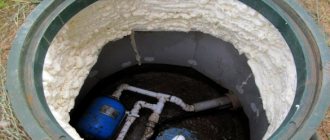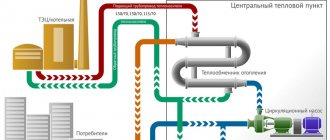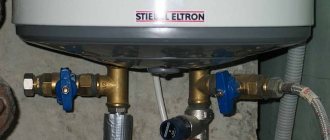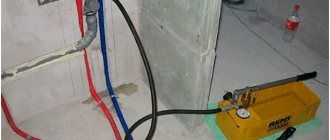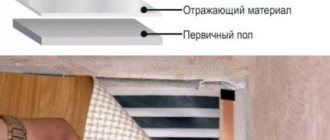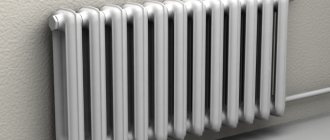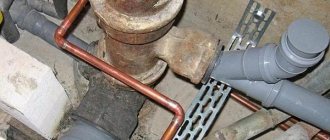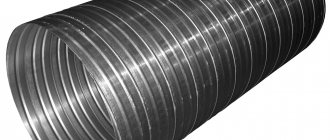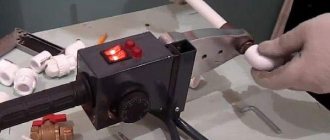Types of valves
To determine the position of the device and find out how the valve opens or closes, you first need to know the type of device installed.
In household systems the following are most often installed:
ball valves. There is a metal ball in the body of the device, which serves as a locking mechanism. The body and locking element are usually made of durable metals (brass, steel, bronze), which ensures a long period of use of the device;
Valve with ball-shaped locking mechanism
plug valves. The locking elements in this type of device are cylindrical or conical plugs. The plug valve body is also made of high-strength metal. The locking mechanism allows the valve to be used in pipelines with aggressive media.
Valve with cylindrical plug
In most cases, ball valves are installed on heating and water supply systems, and plug valves on gas pipelines.
If you need to shut off and remove the radiator
It is best to carry out work related to radiator removal after the end of the heating season. If work needs to be carried out during the heating season, you need to take into account a number of nuances. If you have a single-pipe heating system and vertical wiring, you can remove the battery only if there is a bypass.
Such a system can be identified by pipes, one of which comes from the ceiling and connects to the radiator, and the other comes out of the radiator and disappears into the floor. A bypass is a jumper connecting the incoming and outgoing pipes. This is a pipe of approximately the same or slightly smaller diameter than the main pipes. The principle of the bypass is as follows: if the radiator is turned off, water begins to flow through the riser, passing through the bypass, without passing through the battery. In this case, the riser works, the heating in neighboring apartments does not turn off.
If the system is two-pipe, if there are taps, it is enough to close them, after which you can remove the battery.
Is it possible to turn off the radiator in the summer?
All operating organizations state that they do not drain the system in the summer, but “drive” cold coolant. In reality, the system is drained: for repairs, replacement of pipes or equipment, etc. And although all radiator manufacturers say that it can stand without water for two weeks (or a week) a year, no one guarantees that the system will be filled in two weeks. This situation is not critical for copper and copper-aluminum radiators - copper generally has oxygen or not - it practically does not react to its presence in any way (after an oxide film has formed on the surface).
To avoid damage to radiators, many people close the radiators with ball valves after the end of the season. But you can’t do this: the battery can simply rupture.
If you turn off the radiator in the summer and do not open the air vent, the battery may simply rupture
The fact is that in the presence of water in the radiator, chemical processes occur, which are accompanied by the release of gases. When the taps are closed, the possibility of their exit is cut off. Gases accumulate more and more inside, creating excess pressure. Once it exceeds its tensile strength, the battery will burst. And this will not be a warranty case: the operating conditions have been violated.
This problem is relevant for aluminum ones. cast iron, bimetallic and steel radiators. That is, for everyone. But what to do? It’s both bad and bad. And the solution is this: shut off the battery, but at the same time open the air vent.
If you turn off the radiator for the summer, make sure that the air vents are open and in working order.
Today, every modern radiator has this device. Most often - the Mayevsky crane. This is a small washer with a hole, with the help of which it is necessary to bleed air after starting the system and during the heating season. In manual models, you need to use a wrench or a screwdriver to turn the screw counterclockwise. In automatic ones, bleeding occurs as air appears. But even here there is a screw cap that blocks the exit of gases. So here it is. If you decide to shut off the battery for the summer, make sure that the air vents are open and the air is released (not clogged). It also doesn’t hurt to make sure at least once a month that the air vent is still open, otherwise you never know: the children were playing, or someone absent-mindedly twisted it...
What is required to shut off heating devices?
If it’s hot in the apartment or you need to disconnect the radiator without calling a plumber to shut off the entire heating riser in the entrance, it is important that:
- Between the supply pipe and the return pipe there was a vertical jumper - a bypass; it is through it that the coolant flow will pass without entering the installed battery after you turn it off. The absence of a bypass automatically means that you are cutting off the flow to the entire riser.
- American ball valves must be installed on the supply and return pipes between the bypass and the heating radiator. They are the ones who make it possible to disconnect.
- Ideally, an air valve is installed at the radiator inlet.
Based on the above, if there is no bypass, but ball valves are installed, the battery can be dismantled independently for repair or replacement, but not during the heating season.
The bypass (jumper) is mounted parallel to the radiator and is usually a pipe whose diameter is equal to the diameter of the supply pipes or one step smaller. If you plan to shut off the radiators after the heating season or install a radiator with a thermostat, be sure to take care of installing a bypass. Otherwise, your actions will lower the temperature of the coolant and your neighbors.
Is it possible to shut off by closing both taps?
Let's imagine that you closed both taps while the coolant in the system is still hot.
Knowing the elementary laws of physics, you can easily understand that
:
- As the water in the battery cools, its volume will decrease;
- This will lead to the formation of a vacuum in the enclosed space of the radiator;
- As a result of the resulting pressure, the battery will become deformed or lose its seal and will need to be replaced.
So, in search of an answer to the question of how to turn off the battery if it gets hot in the apartment, you already know that this should under no circumstances be done by closing both taps! Now it remains to figure out whether it is worth using both taps after the heating season, when the coolant has already cooled down.
As we already know, the central heating system stays full all year round. In some areas, the coolant is drained if repair work is required, and then refilled. So there is liquid inside your radiator.
If you turn off both the upper and lower valves, the following happens:
:
- Various chemical processes take place in the liquid inside the battery, since the coolant cannot be chemically pure;
- As a result of these processes, gas formation occurs;
- Since the gases have no way to escape, the increased pressure may cause the radiator to depressurize.
Thus, if an air vent (Mayevsky tap) is not installed on the battery, it is strictly not recommended to close both shut-off valves, even if the coolant temperature is room temperature.
Some features of popular systems
In order to somehow highlight their protection against water leaks, manufacturers are trying to improve reliability or come up with other moves. It is impossible to systematize these features, but it is better to know about them when choosing.
Capabilities of one block
For different manufacturers, one control unit can control a different number of devices. So it won't hurt to know this.
- One Hydrolock controller can service a large number of wired or wireless sensors (200 and 100 pieces, respectively) and up to 20 ball valves. This is great - at any time you can install additional sensors or install several more cranes, but such a reserve of capacity is not always in demand.
- One Akastorozh controller can service up to 12 wired sensors. To connect wireless, you need to install an additional unit (designed for 8 Aquawatch Radio pieces). To increase the number of wired ones, install another module. This modular expansion is more pragmatic.
- Neptune has control units of different powers. The most inexpensive and simple ones are designed for 2 or 4 taps, for 5 or 10 wired sensors. But they do not check the functionality of the taps and do not have a backup power source.
As you can see, everyone's approach is different. And these are just the leaders. There are even smaller campaigns and Chinese companies (where would we be without them) that either repeat one of the above plans or combine several.
Additional functions
Additional ones are not always unnecessary. For example, for those who are often on the road, the ability to control cranes from a distance is far from superfluous.
- Gidrolok and Akvatorozh have the ability to turn off water remotely. For this purpose, a special button is placed at the front door. Go out for a long time - press and turn off the water. Aquawatch has such a button in two versions: radio and wired. Gidrolok has only wired ones. The Aquastore radio button can be used to determine the “visibility” of the wireless sensor installation location.
- Hydrolock, Akvastorozh and some Neptune variants can send signals to the dispatch service, security and fire alarm systems, and can be built into the “smart home” system.
- Hydrolock and Akvastorozh check the integrity of the wiring to the taps and their position (some systems, not all). In Hydrolock, the position of the locking ball is controlled by an optical sensor. That is, when checking there is no voltage in the tap. The Aqua Watchman has a contact pair, that is, at the time of testing, voltage is present. Protection against water leaks Neptune also monitors the position of the taps using a contact pair.
The hydrolock can be controlled using a GSM module - via SMS (commands to turn on and off). Also, in the form of text messages, signals about accidents and “disappearances” of sensors, broken cables to electric taps and malfunctions can be sent to the phone.
Always being aware of the condition of your home is a useful option.
On the issue of reliability: power supply and other issues
Reliable operation does not only depend on the reliability of the cranes and controllers. Much depends on the power supply, on how long each unit can operate autonomously.
- Aquawatch and Hydrolock have backup power sources. Both systems shut off the water before the backup power supply is completely discharged. Neptune has batteries only for the last two models of controllers, and then the taps do not close when discharged. The rest - earlier and less expensive models - have a 220 V power supply and no protection.
- Neptune's wireless sensors operate at a frequency of 433 kHz. It happens that the control unit “does not see” them through the partitions.
- If the batteries in the Gidroloka wireless sensor run out, the alarm on the controller lights up, but the taps do not close. The signal is generated several weeks before the battery is completely discharged, so there is time to change it. In a similar situation, the Aqua Watchman shuts off the water. By the way, the Hydrolock battery is soldered. So changing it is not so easy.
- Aquawatch has a lifetime warranty on any sensors.
- Neptune has wired sensors that are installed flush with the finishing material.
We looked at all the features of the three most popular manufacturers of water leakage protection systems. In short, the worst thing about the Aquawatch is the plastic gearbox on the drive; the worst thing about the Hydrolock is the high power of the system and, accordingly, the price. Neptune - inexpensive systems are powered by 220 V, do not have a backup power source and do not check the functionality of the taps.
Naturally, there are Chinese leakage protection systems, but you should choose them with caution. https://www.youtube.com/embed/EW3HuvRojwA
What to do if the fluid leaks
The problem of faulty plumbing worries many; even on the Internet you can often find queries on this topic, for example, “faucet is leaking, how to fix it, video.” Meanwhile, most faults are easily fixed.
Currently, the most common are single-lever faucets with a cartridge (faucet axle box). Both hot and cold water in such a mixer are turned on by lifting a single lever. Most often, incorrect operation of faucets of this type is caused by a cartridge that has become unusable. In this case, you just need to replace the cartridge with a new one. For repairs, you will need a small flathead screwdriver, an adjustable plumber's wrench and a new cartridge.
The faucet is leaking in the bathroom or kitchen. Procedure:
- Turn off hot and cold water.
- Remove the upper part of the lever-handle.
- If there is a protective clip blocking access to the screw, remove it.
- Use a screwdriver to unscrew the screw.
- Now carefully remove the lever and unscrew the decorative cover covering the cartridge nut.
- Using an adjustable wrench or a suitable wrench, unscrew the nut and remove the cartridge by hand.
- Insert a new cartridge and repeat all steps in reverse order.
- All that remains is to restore the water supply and check the operation of the tap.
Possible problems
If we are considering the question of how to shut off the water supply in the bathroom and toilet, it is necessary to immediately list the most common problem situations. This will allow you to protect yourself and protect yourself from negative consequences.
Sticking of the main shut-off valve
Most often, the problem is associated with infrequent use of this element. To solve this, you can first try to loosen the oil seal by unscrewing the clamping nut counterclockwise. Experts do not advise completely unscrewing the nut, because there may be a leak in this place. If the manipulation does not help achieve the desired result, it is better to entrust the matter to professional, experienced specialists and contact a qualified service.
AMETHYST - 02 M Residential building for up to 10 people or up to 2 cubic meters/day.
Aeration unit AS-1054 VO-90
Main table dispenser AquaPro 919H/RO (hot and cold water)
Water flows along the spindle
If you open the tap, in some cases you can detect a leak from the clamping nut. As a solution, first try tightening the oil seal using a clockwise rotation motion. As a result of a tightly tightened nut, increased pressure is exerted on the mechanism, which causes the part to burst and ultimately leads to its failure. Ultimately, this can lead to difficulties during operation. As a solution, you can consider tightening the nut or completely replacing the stuffing box.
The water does not turn off with the shut-off valve even when closed.
Most likely, the problem is in the gasket, which has already served its purpose and can no longer cope with the assigned tasks. In this situation, it is first of all important to check whether the valve is actually completely closed. Next, you should think about closing the element that is located outside or contacting qualified specialists with experience.
Flow does not resume even when the shut-off mechanism is in the open position
Surely you know how to open the shut-off water in an apartment - you need to turn the shut-off valve. However, in a number of cases the situation is not restored; most often, the reason lies in the fact that the gasket is stuck to the seat, having become detached from the spool. First, try hitting the device to make it fall off on its own. But, most likely, this will not give the desired result and you will have to disassemble the entire element.
How to shut off a heating riser
The heating riser belongs to common property. It must be blocked by employees of the service organization who have the right to do so.
If you follow the letter of the law, you must come to the DEZ, Housing Office, DEU, etc. write an application, pay for the service at the cashier. At a certain time (indicate in the application) a representative of the service organization must come and turn off the valve in the basement.
How much does it cost to turn off the heating riser? This is not an easy question. The fact is that there are no fixed prices. There is a price list for services, but it is only a recommendation. In reality, each organization sets its own prices. On average, you will have to pay from $15 to $20 for this operation.
The valve that shuts off the heating supply is located in the basement of the house
There is a workaround. Agree with neighbors and shut off the riser yourself without the campaign’s knowledge. But you know that this is not always possible: neighbors are different. If in the summer, when the heating is turned off, such actions may meet with understanding, then during the season - it is unlikely. There is another difficulty: the heating valve is not always easy to find. You either need to have a communication scheme, or just know where it is. They usually know a locksmith. But they won’t block the riser for free, and will require at least $10-15. There seem to be savings, but they are small. And if this fact becomes known to the management or operational company, you will face substantial fines.
Who to entrust the work to?
Since you will still have to pay, it is better to do everything at once. In any case, with all the radiators on one riser. And here the question arises: who will carry out this work. To get started, you can go to the housing office or departmental office and ask about their prices. As a rule, the prices there are rather high, and the quality of work is not up to par. To make sure of this, you can ask neighbors who have already dealt with them.
You can find a private owner. Just not from advertisements, but from the recommendations of acquaintances, colleagues, friends. Their prices are rarely higher than those of operators. And the quality is better - this is their bread: if they do a bad job, there will be no customers. That’s why they try (if they are sane) to do everything conscientiously.
Choosing a performer is not an easy task
There is still an opportunity to negotiate with the housing office employee by bypassing the cash register. But here the option is controversial. Firstly, they tend to ask for a price based on the client’s wealth and it is far from a fact that they will demand less than the price list. More likely - more. Why, tell me, should they pay more for the same quality of work (it is unlikely that they will work more diligently than at their main job)?
Another option is to contact a specialized organization. And again, preferably based on recommendations. Although, organizations are forced to monitor the quality of work for prosaic reasons: they need clients. If they have a bad reputation, no one will go to them
Therefore, if you don’t know the organization, there are no recommendations, you can pay attention to the period of its existence on the market. If it’s not a year or two, then they definitely know how to do something, otherwise they wouldn’t have existed for so long
Naturally, pay attention to the services they provide. Many people suggest that issues with permission and disconnection of risers should be handled by the management or operating organization. You just specify the list of works and time. How expensive will it cost? In different ways: organizations, like their leaders, are different. It may be more expensive than the work of a mechanic from the housing office, but at least you will have someone to file a claim with in case of problems: you sign an agreement that will clearly outline who is doing what.
And the most economical option: do everything yourself, with your own hands. It’s not an easy task, but it’s not the gods who burn the pots. Just first you need to find out everything down to the smallest detail, purchase everything you need, prepare tools and equipment, and only after that write an application to turn off the riser.
This all concerned planned repairs or preventive maintenance. If a radiator or pipe is leaking, you definitely have to take action yourself. Read how to fix a radiator leak here.
Eliminating whistling, humming and noise
In addition to a banal leak, the following problems are quite common: the tap turns; weak water pressure in one of the taps; noises that appear when the water is turned on.
First, let's figure out why the faucet whistles (or hums). Noises can be caused by a worn gasket on the faucet valve or a poor-quality cartridge on the mixer. Change the gasket to a new one (made of thick rubber) or a low-quality faucet axle box to a ceramic product from a reliable manufacturer and the whistle when turning on the water will disappear.
What to do if the water from one tap flows in a weak stream? Presumably, the problem can be caused by a clogged coarse filter installed on the mixer or tap. It is enough to clean and rinse the filter and the water pressure will be restored. The reason may be even more trivial - a clogged mesh on the faucet tap; it can be easily unscrewed and washed.
Valves rotate due to worn threads or a leaky gasket on the valve head. This happens due to torn or worn threads. To eliminate the problem, replace the valve with a new one. If the thread is in order (this can be seen during disassembly), simply change the gasket.
What to do if the water supply is clogged?
It may happen that the water from the tap flows in a thin stream or stops flowing completely. Sometimes the culprit is utility workers who for some reason turn off the water supply (even now this happens in some places). If this is not the case, then a decrease in pressure indicates that your water pipes are clogged. Therefore, urgent measures need to be taken. And the first such measure will be a survey of neighbors. If everything is in order with their pipes, it means that there is a blockage in the water supply in your area. If their water also disappears, then the utility workers should worry.
Clogged filter on spout
It may happen that the pressure in one faucet (say, in the kitchen) has dropped sharply, both for hot and cold water, while other faucets (in the bathroom, etc.) are working normally. In this case, the filter on the faucet spout is most likely clogged. This problem is very simple, and solving it is not difficult. The filter must be opened with an adjustable wrench or with your hands (if your hands are strong enough or the filter is not screwed in tightly), and then remove the accumulated dirt from its back side. After this, the filter is put in place, the tap is opened - and, to our joy, the pressure in the tap is normal again.
How to shut off the battery
To perform some work, you only need to turn off the radiator:
If shut-off valves are installed - ball valves. This is easy to do: you need to turn the tap handle until it stops on the supply and return pipes. The coolant flow is blocked, the heater can be removed.
If there are ball valves in front of the radiator, close them and remove the radiator
Sometimes a manual control valve is installed at the supply. It can also shut off the coolant supply, but its main function is to regulate: it is installed to maintain a constant temperature in the room.
If the heating season is over, after closing the taps, you can safely remove the radiator. If there is a need to carry out work during the heating season, it is necessary to take into account the peculiarities of the installation. In a single-pipe system with vertical distribution, shutdown without stopping the system is possible only if there is a bypass.
A one-pipe system with vertical wiring looks like this: one pipe comes out of the ceiling, goes to the radiator, the second comes out of another hole in the battery and goes to the floor.
The bypass is a jumper placed in front of the radiator. It connects the supply and return pipes. It is usually carried out with a pipe size one step smaller than the diameter of the liner.
If there is a bypass, then when the radiator is turned off, the coolant continues to circulate through the riser, but already flows through this jumper. As a result, no one suffers: the neighbors are warm, you carry out the required work.
The bypass is a jumper in front of the battery. In the photo on the right, even though there is a bypass, there is nothing to shut off the battery: there are no ball valves
When connecting using a two-pipe scheme, there are no problems: there are taps, close them, remove the radiator. With a single-pipe system, but with horizontal wiring, jumpers are also needed. But, in their absence, you will freeze your apartment.
In general, a bypass is a very necessary element: if necessary, it allows you to install a thermostat (thermostat) at the inlet of the radiator, with which you can maintain a constant temperature in the room. Without this jumper, installation of control devices is prohibited. It’s just that without it, it turns out that you regulate not only the temperature of your battery, but also the entire riser, which is unlikely to please your neighbors.
But just the presence of a bypass does not guarantee the ability to turn off the battery during the heating season. There should also be ball valves on the supply and return. Moreover, it is better to take full-bore valves for heating radiators. There are also standard ones. In them, the clearance in the open position is approximately 70-80% of the diameter. In full bore models it is 100%. To ensure normal heat transfer, they are exactly what is needed.
The battery can be disconnected at any time if there are ball valves at its inlet and outlet. But to ensure that heat transfer does not decrease, it is necessary to install full-bore models
If there is no bypass, to carry out all this work you will have to turn off the riser, and this is not done soon, and even at a cost.
DHW
When there is any hot water leak in your apartment, the first thing you do is turn off the valve or ball valve on the supply line.
Taps on cold water and hot water supply lines
If the leak occurs before the valve (on the heated towel rail, riser, or at the seam between the riser and the supply line), or if they drown you from above, your path lies in darkness and dampness. Into the basement.
Signs of a hot water leak
- The apartment is heated in the rooms in which hot water is supplied, or in those adjacent to them;
- You are flooded with warm water from above;
Let us clarify: in the kitchen, it is sometimes possible to localize the cause of a leak only by the location of the leak on the ceiling (closer to the sink or heating device).
A leak near the kitchen heating riser allows us to identify the cause of the leak
- The water flows continuously.
Finding and disconnecting the riser
In houses built before the early 80s, turning off the hot water supply is completely identical to turning off the cold water riser. The hot water supply system in these buildings is a dead-end, and each riser is connected only to the bottling and supply lines in the apartments.
In most newer multi-apartment buildings, the hot water supply is circulation. For us, this means that each riser is connected by a jumper on the upper floor with other risers (there can be from one to six).
Sign of hot water circulation - two hot water dispenses
Hint: most often the DHW is looped to the apartment (if it has at least two DHW risers - in the kitchen and in the bathroom) and to the entrance.
The sequence of actions when turning off DHW with circulation is as follows:
- Close your riser and partially (we emphasize once again: partially!) Unscrew the plug;
A partially unscrewed plug allows you to control the pressure in the riser
- Block adjacent risers one at a time without touching the plugs on them. You need to wait until the pressure of the water coming from under the plug on your riser drops;
- Then open the taps one at a time. If the pressure does not increase, the riser is not connected to yours, and it needs to be fully opened;
- Having found all the risers combined into a group, unscrew the plug on yours.
If even one piece of fittings is faulty, you will have to turn off the hot water supply for the entire house. In the most common houses in the post-Soviet space with an open heating system (read: hot water supplied from the heating network), this is done in the elevator unit.
Disabling DHW in the elevator
First, a little theory.
Heating elevator unit
The heating elevator unit includes:
- Input shut-off valves (gate valves, ball valves or valves), cutting it off from the heating main. The upper valve turns off the supply thread, the lower valve turns off the return line;
Inlet shut-off valves - ball valves
- House fittings that turn off the heating system of the house;
- Control valves and pockets for measuring temperature;
- Suction - a jumper connecting the supply to the return;
- The water jet elevator to which this jumper connects. It is a tee with a socket on one of the branches and a nozzle installed inside.
Elevator with nozzle
The nozzle is responsible for the dosed supply of hot and high-pressure water from the supply into the mixing chamber, where it mixes with the return water that has cooled in the heating circuit. Thus, part of the return coolant is drawn into recirculation; Thus, the elevator provides a large volume of circulating liquid with its minimum flow rate on the supply pipeline of the heating main.
Operating principle of the mixing chamber
Please note: the water jet elevator always faces the heating system and house valves.
DHW taps are located between the inlet valves and the elevator. Usually there are 2 of them (in a dead-end DHW system) or 4 (in a circulation system). To turn off hot water for the entire house, all taps must be closed.
Black pipes and valves in the foreground are hot water connections
Hint: the fittings in the elevator unit also undergo annual inspection by representatives of Heating Network, so malfunctions are extremely rare.
Manufacturer Ariston
How to turn on the Ariston boiler? First of all, you will need to fill the boiler with water and connect the device to the power supply. Within the first couple of minutes, the indicator panel will start working. At the moment, your boiler is not yet turned on, as indicated by flashing temperature indicators.
In order for the device to start working, press the “turn on” button; on the display you will see the current water temperature in the tank. In order to select the temperature you need, press the “+” or “-” buttons; by pressing any of these keys, you will switch to the temperature selection mode. The temperature is available in the range from 35 to 70 degrees.
The manufacturer also equipped its models with the ability to change the available power: 1500 or 2500 W. You can activate this setting by pressing the “power” button for a couple of seconds. The boiler does not have a memory function, so when it is turned off, the settings will be reset.
The Ariston mechanical model has even more simplified controls. After you have connected the boiler to the power supply, press the “turn on” button - it will light up red. As soon as the water reaches the desired temperature, the power button will go out.
The power of the mechanical model can also be increased. Its main feature is that while the water heater is operating, the red shutdown button lights up. As soon as the device stops working, the button goes off. This immediately lets us know that the water is ready for use.
How to turn off the water
This can be done in a separate apartment only if there are special valves in the bathroom. But this method is appropriate only when minor work is planned. For example, repair a faucet. If you plan to install plumbing in a toilet/bathroom or other labor-intensive work, you must shut off the water along the entire length of the riser. This design is a pipeline. The riser is intended for 1-2 apartments.
Shut off using a tap
If there is a valve in the bathroom, you should turn it clockwise until the end. What to do if the apartment is old and there is no valve? In this case, you will inevitably have to contact a specialist from the housing office. The plumber will not be able to turn off the water in a single apartment, only in the entire entrance.
In the event that a main pipe bursts, the entire house is shut off. This work may even affect several buildings.
The pipes in the bathroom and toilet located in new buildings usually have valves. Using them you can easily turn off the water in a separate apartment. In other cases, there is even a special sensor on the pipes that automatically detects problems and turns off the structure.
How to turn off the water in the toilet riser?
The riser is usually located in the toilet or kitchen. Its main purpose is to supply water. It can be overlapped only if there are valves on the structure. If they are not there, you need to think about installing the elements. The best choice in this case would be ball valves.
If old elements with defects are installed on the pipeline, it is better to think about replacing them, because in the event of an emergency they may fail and you will flood your neighbors. It is better to entrust their installation to a specialist. A plumber will be able to determine what diameter of the product is required specifically for your riser.
After installing the valves, you must not forget about the importance of preventative maintenance. Once every three months it is recommended to turn off the risers and then turn them on again
This is necessary so that the elements do not stagnate and cope well with all their functions. It is better to prevent their breakdown, because in an extreme situation the valves may fail, and you will not be able to do anything about it. If any problems arise, it is better to call a technician who will check the condition of the valves and carry out the necessary repair work.
In conclusion, we can say that turning off the water is easy only if a person takes care of it in advance. If the valves have not been installed, it is almost impossible to turn off the valve in one apartment. For this reason, it is better to get ahead of the occurrence of further problems and install them, because shutdown may be required not only during repair work, but also in the event of emergency situations.
https://trubygid.ru
How to turn off a shut-off valve located outside
To avoid problems and negative consequences, experts do not recommend performing any manipulations with this element. But in a number of situations that can be classified as emergencies, it may be necessary to dig up the earth around the element to provide access to it.
The device is located at least 75 cm (the indicator directly depends on the region and such an indicator as the freezing depth, for example, in Moscow it varies from 0.8 to 2.5 meters). This dictates the need to use a specialized wrench, which helps reach the flywheel at the level of its location and allows you to quickly turn the tap itself.
How to shut off the water pipe in a sink or other plumbing when using a low pressure pipeline
If the supply is from a house inlet, closing the tap mechanism will stop the flow of the resource. If the flow continues, it means that the liquid comes from a specialized storage tank. You can just wait, because when you turn it off, the capacity will quickly empty. If you have limited time, close the shut-off valve on the pipe itself that comes out of the storage tank. To do this, turn the flywheel clockwise.
Main table dispenser AquaPro 929CH/RO (cooling/heating)
Floor dispenser AquaPro 311 (empty, without cooling)
Floor-standing dispenser AquaPro 6207CH (cooling/heating/room temp.)
This raises the logical question of where the water in the apartment is shut off in this case. Most often, this is done in the attic of the building, which is where the tank itself is located. In a number of houses, the container is located on the top floors, in built-in closets specially designated for this purpose.
It is important to consider that this type of design is different from the usual one. In Europe, for example, gate valves are used in devices of this type. But recently, they are increasingly being replaced by more modern and efficient disc or ball valves with special handles that rotate 90 degrees.
If your system uses a gate valve, it is likely blocking only the bulk of the water flow and allowing only a small amount of liquid to pass through. This option cannot be called an effective solution. In a number of situations, this fitting does not work at all or works with varying degrees of success. The use of ball elements allows you to forget about a number of problems. To close them, you need to turn the handle ¼ turn so that it takes a perpendicular position relative to the water pipe. When choosing a faucet, make sure that it provides full clearance. Otherwise, after installation, you may experience a reduction in flow.
If searches remain unsuccessful or the installed equipment functions with irregularities and defects, it is better to close the outlet of the storage tank with a special plug. Next, you can lift the lever to stop the water supply to the system. If the reservoir feeds a water supply, draining allows the flow to be stopped.
